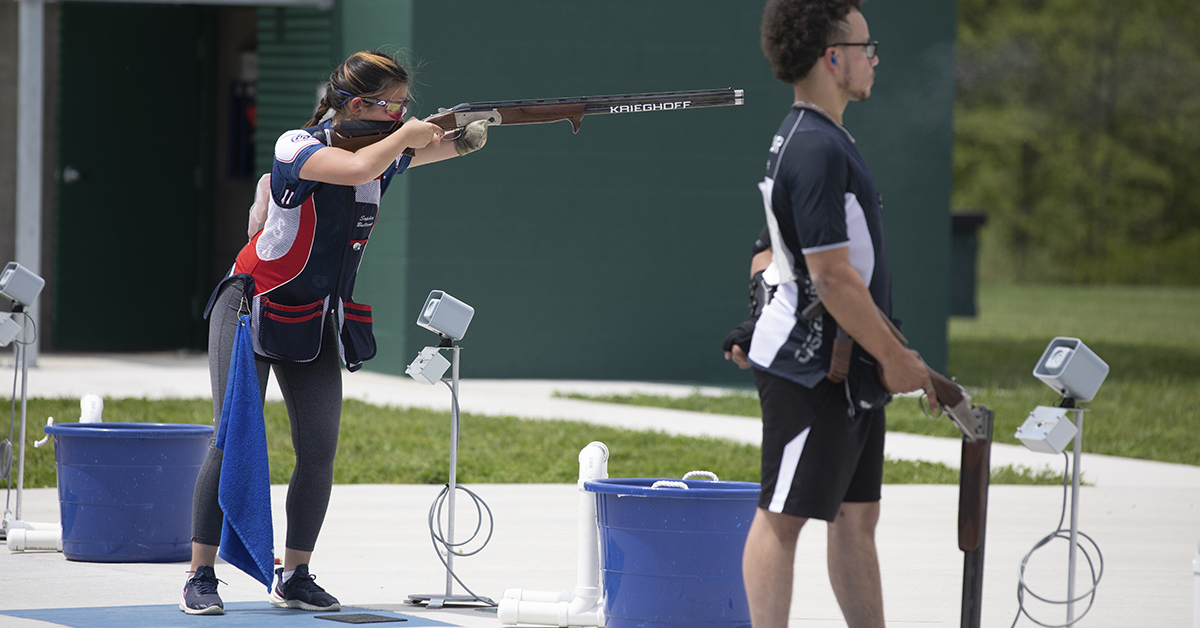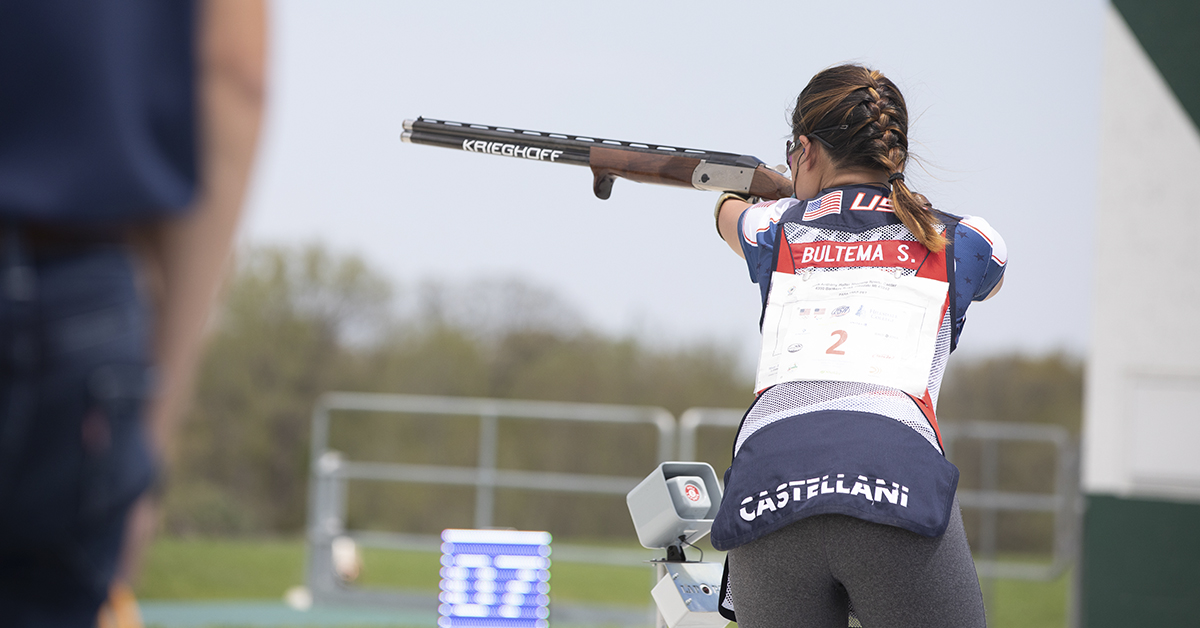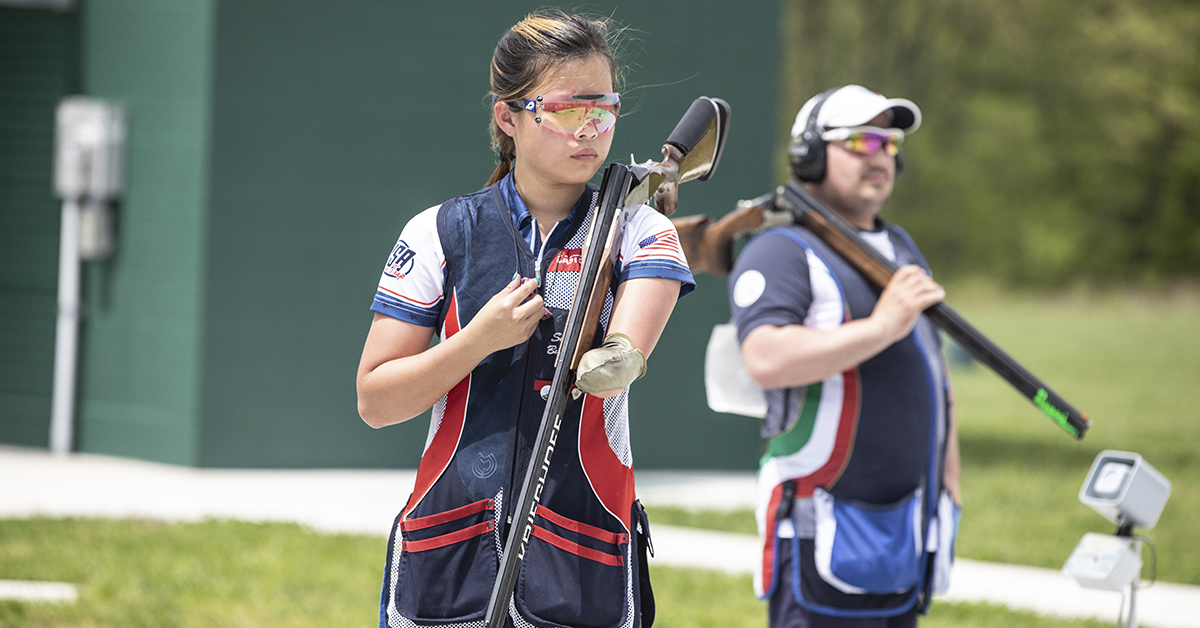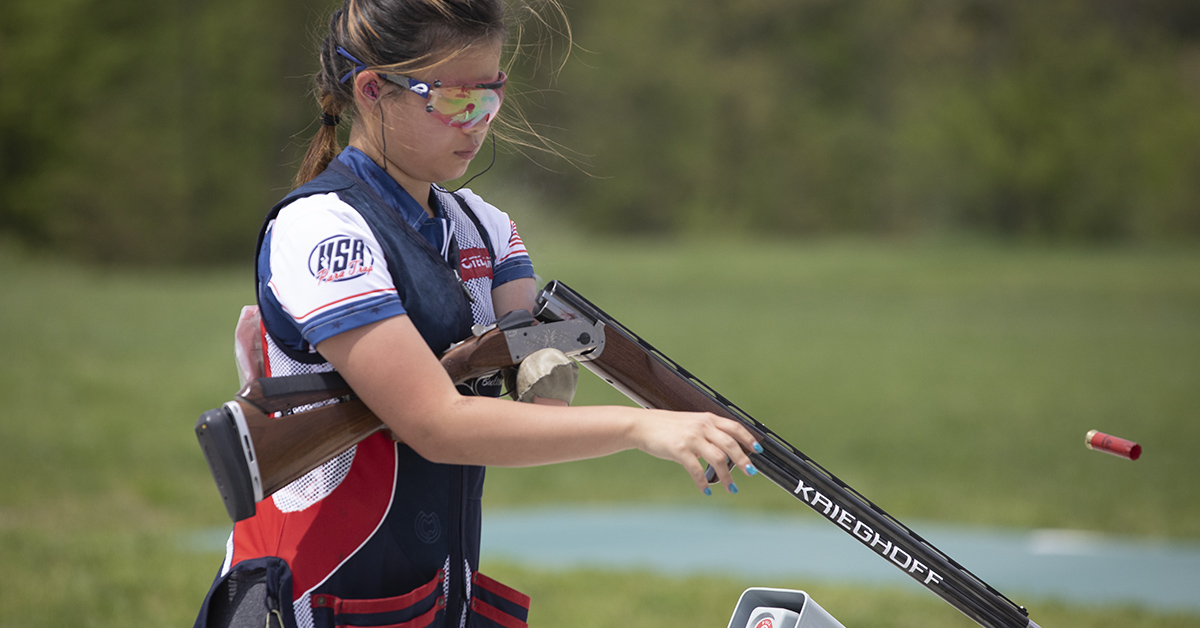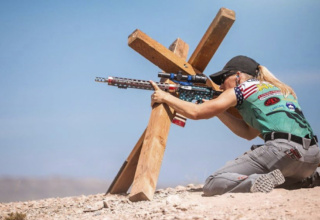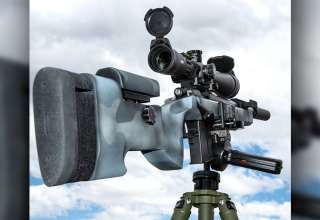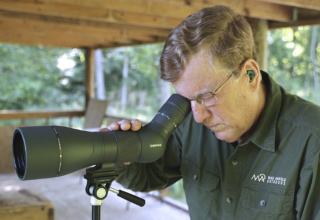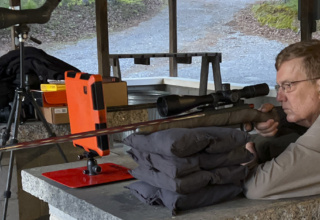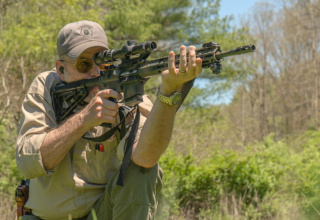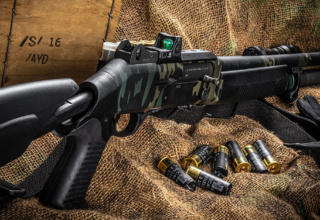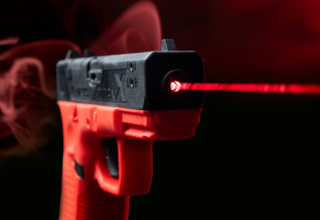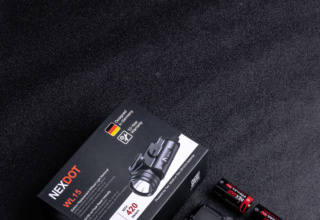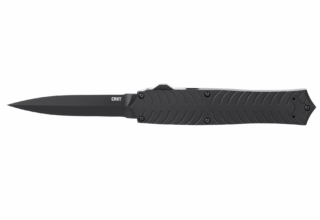Champion shooter Sophia Bultema’s pursuit of excellence makes her prime competitor…herself
by Mike Arnold
Her soft replies, accompanied by a winning smile, put me at ease. Yes, I was the “interviewer,” but the person on the other end of my questions was better at this than me. In fact, the entire Zoom call became a lesson for me in how a top athlete can approach life with humility and grace while, at the same time, exhibiting a steel determination for excellence issuing from a deep reservoir of competitive drive. In world class athlete Sophia Bultema’s case, her excellence has already been shown through a long list of invitations to national and international shotgun competitions, and a world record set. Also reflecting her excellence are two major sponsors: Winchester provides the AAs Sophia shoots by the barrel full, and Krieghoff the shotgun whose sleek lines extend from Sophia’s shoulder and cheek as she leans forward waiting for the Bunker Trap to explode out a target.
My first questions for Sophia I considered potentially awkward for her, including her origins and how she made it to the US. Again, her self-effacing manner stopped me in my tracks.
Sophia began her life in the Chinese Province of Henan, in the city of Puyang, in an orphanage. Just before her sixth birthday, her adoptive parents walked into her life and chose her as one of their own. They took Sophia to the United States — a journey no less transformational than those taken by the explorers and adventurers who, thousands of years before, began their own westward passages from this end of the Silk Road.
Landing in the beautiful environs of Colorado Springs, Sophia began her new life as the daughter of a CEO dad and a nurse/midwife mom, and a sister to six siblings (two who are also from China). I asked if any of her siblings also participated in the shooting sports. Her answer was that her dad and brothers enjoy shooting and hunting. Her winning smile returned when she went on to explain that her sisters and mom don’t like loud noises, so don’t like being around guns. She admitted, “Of course, I don’t like loud noises, either, but then again, I have sooooo many pairs of ear plugs, I’m OK.”
My thought was, “I bet you do, when everybody wants you filmed wearing their products!”
Jealousy aside, I marveled again at how relaxed, confident, humble, and, in this instance, alert, Sophia was. Though working from less than three hours of sleep and having taken her last final exam of the Hillsdale College Spring 2024 semester only two hours before our Zoom meeting, she was bright and responsive. “I’m doing great,” she said, grinning and lifting the can from which she sipped, “I have a power drink!”
My next series of questions focused on the heritage of shooting surrounding Sophia as she grew up in Colorado Springs. Who taught her to shoot?
She revealed that her first firearm was a gift from her grandfather when she was around 10-years old. “It was a purple .22 rimfire rifle,” she said with a grin. “My parents own property where my dad and brothers go hunting, and we use the land between hunting seasons for shooting pistols and rifles, like my purple .22.”
In terms of shotgun shooting, in which she now competes at a world class level, that didn’t begin until her freshman year in High School. “My dad and High School coach taught me shotgun shooting. I shot trap and a small amount of skeet, beginning with a 28-gauge, and slowly…very slowly…worked my way into being comfortable with a 12-gauge.”
I went on to ask Sophia if she joined her dad and brothers on their hunts. This time she didn’t smile, but instead grimaced. “Obviously, I have nothing against hunting, or hunters, but I did not enjoy the one time I went out with my dad and brothers. We went for pheasants, and I did not enjoy killing the birds.”
She seemed, for the first time in our conversation, a bit uneasy when she finished with, “I guess I’m a shooter, not a hunter.”
I told her that my wife was exactly the same. I related Frances’ love of shooting, particularly handguns, but her lack of any desire to hunt. I encouraged Sophia that most people in the US fell into the non-hunting camp, but that we hunters needed their support as well. I finished with the reflection that her support of the 2nd Amendment through her love of shooting and the dollars she spent — or spent by her sponsors — on the equipment for her sport went straight into conservation of lands for hunting in Colorado and elsewhere. “Besides,” I said, “I bet you enjoy the meat brought back by your dad and brothers.”
Again with the smile!
The topic of our conversation now turned specifically to Sophia’s competition in the sport of Bunker Trap. The following description of Bunker Trap comes from the USA Shooting website.
“Also known as International Trap or Olympic Trap, Bunker is the official trapshooting discipline of the Olympics. Olympic competition occurred for the first time in 1900. The International Shooting Sport Federation (ISSF) governs the sport, with USA Shooting recognized as the governing body within the United States.
“While Bunker and American Trap share similar names, the disciplines are quite different. Bunker also has five shooting stations, but rather than having only one machine in a trap house, it has fifteen fixed machines housed in a bunker. The targets fly faster and at a wider angle than American Trap, which makes it considerably more difficult.”
As stated, the difference in difficulty of Bunker Trap compared with American Trap comes from both the extreme, horizontal, angle at which the clay targets can travel, up to 450 in Bunker vs a maximum of 220 in American Trap, and their speed (45 mph for American and 68 mph for Bunker). In fact, the trap machines used in Bunker throw the clay ‘birds’ so fast that they must be specially hardened to prevent disintegration during their launch. The machines can also throw the targets at higher and lower angles than American trap machines. Sophia’s comment about this level of difficulty came in the form of a joke among Bunker competitors.
“When you think you’re getting the hang of it, you will end up in a slump.”
To illustrate this, Sophia, when asked about her most cherished accomplishment, cited setting the Junior World Record in the PT3-Mixed Trap Standing event.
“And that is when I thought “I’ve got this,” she said. “All I have to do is keep doing each step in the right order, and in exactly the same way, and I’ll keep breaking the clays. And that is when a slump began.”
Of course, as a non-world class shooter, I wondered how those who are work out of a slump.
“You need to remember that once you have the basics down, Bunker Trap, and shooting in general, is mostly mental,” Sophia reflected. “So, for me, success comes from a mental attitude where I am trusting my gut. My feelings. When I’m in that frame-of-mind, my reactions are effortless, rapid, and instinctive.”
With the goal clearly defined, Sophia goes about changing her routine. She also focuses on her workout regimen — heavy bouts of cardio, weightlifting, crunches, et cetera.
“My core has to be very, very strong so that my reactions can be very precise and fast.” The smile is back. “One of my teammates tried out my stance and after a round she turned to me and said, ‘My entire core and my arms are on fire! How do you do this?!’”
Her teammate’s reaction to trying Sophia’s ‘stance’ brings us to a very important fact about this remarkable young woman.
At birth, Sophia had only a partial left arm, ending at approximately elbow level. With her physical makeup, firing a long gun requires a stance causing incredible strain on the skeleton, ligaments, tendons, and muscles. Hence, her teammate’s body being ‘on fire’ after only a small number of targets thrown from the Bunker.
“My struggle is with high targets and ‘rights’,” Sophia explained. “But those are the targets everyone finds difficult. The key for me is extra precision and speed in my swing. I need these because having only one hand limits my range of motion.”
I marveled at Sophia’s lack of self-consciousness in the matter-of-fact manner in which she spoke about what others might call a “disability.” It was obvious that she saw it as just one more piece in the tapestry making up her life and her world-class athletic abilities. As a parent, I silently made an internal wager that this outlook derived from a nurturing family life. I hoped I would meet her parents someday to congratulate them on rearing such a daughter.
Our time was drawing to a close, and I wanted it to end with reflections on what Sophia enjoyed about her life as an internationally recognized Bunker Trap shooter. She didn’t hesitate with her enthusiastic answer.
“My favorite thing is the opportunity to travel all over the world, meet people, and eat the food of different countries!”
“But,” I asked, “what about winning the competitions and being the world record holder in your sport?”
After listening to her during this interview, I wasn’t really surprised by her answer to this question. She frowned with concentration before responding.
“I am extremely competitive, but with myself. I always want to better what I did before. I want to break my world record, make the podium at the World Competition, and go to the Paralympics in Los Angeles in 2028. Ten years ago, I never would have guessed that we would be discussing what I have accomplished. The people I’ve met, the places I’ve been, the opportunities given to me are mind blowing. But I don’t enjoy beating others at the competitions. I feel bad for them.”
My final question reflected on the fact that, at the present time, there is no shotgun competition included in the Paralympics. I asked Sophia what her prediction was as to whether the Olympic Committee would add Bunker Trap to the event menu for the LA Olympics. She gave me one final smile and said, “I really am not involved in the politics. I’m focused on improving and preparing for the World Competition in June at Hillsdale College’s Halter Shooting Sports Education Center (and the home facility for USA Shooting). I am hoping that those in charge of the Paralympics will see Bunker Trap as I and others who compete do — incredibly exciting and filled with shooters who passionately love their sport.”
- TESTED: Vortex Razor HD Spotting Scope…Clarity for the Distance - July 24, 2024
- Shooting for the Mile! - June 19, 2024
- Instinctive and Relaxed - May 22, 2024

